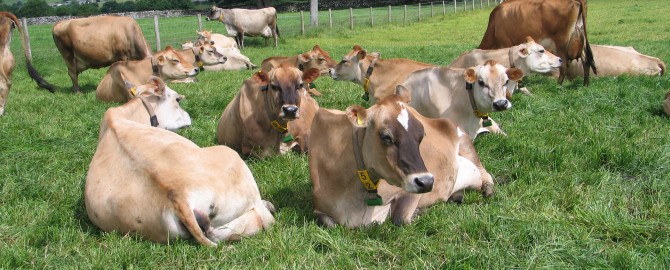Relevant Products
- Revolution (PDF)
- Rolled Maize (PDF)
- Protected rapeseed meal (PDF)
Fertility for the high genetic merit dairy cow is declining. For every 100 dairy cows inseminated for the first time, only approx 34 are expected to conceive and carry a calf to term. The percentage of oestrous animals standing-to-be-mounted (STBM) has declined from 80% to 50% over the past 30-50 years and the duration of STBM from 15h to 5h.
Excellent nutrition is a requirement of good reproductive performance, and this includes milking cow, dry cow, transition cow and heifer rearing diets. In dairy cows, successful reproduction is the result of a chain of events including resumption of oestrous cycles postpartum, development and ovulation of a healthy egg, fertilization, embryo development, implantation in the uterus, maintenance of pregnancy and parturition. Failure at any stage means failure of the whole process.
This document will address the relationship between nutrition and fertility, in terms of negative energy balance, body condition score, dietary protein and mineral nutrition.
Negative energy balance (NEB)
The most common and most important nutritional cause of reproductive failure in dairy cows is the inability of the diet to supply sufficient energy for milk production. The largest NEB is likely to coincide with peak milk yield. The duration of NEB is variable but often ends between 8 and 12 weeks after calving.
A period of NEB invariably occurs in high production cows in early lactation regardless of diet and management. However, higher milk yields do not necessarily result in greater energy deficiency; dry matter intake potential has a big influence on the likely energy status. In addition, NEB will be made worse by diseases such as hypocalcaemia or by poor diet formulation, feeding facilities or management.
In situations of NEB fewer large follicles develop and fewer follicles ovulate resulting in poorer fertility. Energy deficiency also reduces embryo survival. Progesterone concentration is reduced in cows in NEB meaning that they are unlikely to stay pregnant. In addition, NEB can result in poor tissue repair in the uterus after calving, which would affect implantation.
What can be done?
- High genetic merit cows fit best in a system with high feed inputs in keeping with their production potential, it may be desirable to avoid low input systems with high genetic merit cows.
- It is well recognised that a period of poor fertility is often associated with radical changes in diet, and this is especially marked with turning cows out to spring grazing. Many problems seen in association with grazing, in particular the period following turnout to spring grazing, are likely to be due to an increase in energy deficiency due primarily to lower than predicted intakes. Achieving high intakes at grazing requires excellent management of grass and cows and may not be suitable for cows of very high yields due to the difficulty of achieving high forage intakes.
- NEB is almost unavoidable in high production cows in early lactation; the aim is to reduce the magnitude (a maximum loss of 1 BCS) and duration (no more than 42 days) of NEB. Metabolic blood profiles can provide useful additional detail allowing you to assess the size of the problem.
- Feed must be accessible, palatable, consistent and available ad-lib to maximise intake for all cattle including heifers.
- Avoid sudden changes in feeding, the rumen will take at least 2 weeks to adapt to any changes made, this includes changes in forages.
- Judge the success of your rations on reproductive performance and health as well as milk production and quality.
The effect of BCS at drying off, calving and insemination
Fat cows are problem cows. Cows that are fat (BCS > 3.5) at drying off eat less, mobilise more body tissue, lose more weight, and body condition than cows that calve in moderate condition. Fat cows are three times more likely to develop fertility problems than dry cows in good condition (BCS 2.5 to 3.5). These problems include cystic ovaries, metritis and delayed return to oestrous activity. Also, fat cows have fat deposits in the pelvis; this greatly increasing the risk of calving problems. Cows with problems at calving have a greater risk of impaired fertility.
In addition, very thin cows have longer periods between calving and the resumption of ovarian activity and longer calving to conception intervals. Extremes of body condition, <1.5 or >4, will reduce reproductive performance.
What can be done?
- Diets should be adjusted 2-3 months before the end of lactation to dry cows off at 3.5 body condition score. Do not rely on making changes in body condition during the dry period. The aim in the far off dry period is to feed to maintain this level of condition. Cows will typically consume 12-13kgs dry matter and have a requirement of only around 90MJ energy and 13% crude protein. Hay or straw can be used to maintain rumen fill.
- Group cows into dry and transition.
- Straw can be fed in the dry period and then they need to go onto the milking cow diet in the transition period. By doing this you will be preparing the cow’s gut so that it is at its maximum efficiency when enters the milking herd.
Dietary protein
Generally, high concentrations of dietary protein reduce cow fertility, but there are considerable differences in the concentration of protein above which fertility is impaired. The results suggest that excessive amounts of rumen degraded protein are possibly the cause of the depressed fertility.
Excess protein can results in high concentrations of blood urea (>200 mg/litre) which affect reproduction through toxic effects of ammonia and its metabolites on eggs, conception and early embryo survival. Alternatively, excess ERDP (relative to FME) would predispose the animal to impaired fertility. Therefore it is desirable to formulate diets to avoid excesses of ERDP. Replacing ERDP with DUP may not resolve the issue and this as it may still lead to high blood urea levels.
What can be done?
Diets should be formulated so that they don’t contain excess ERDP. Also monitor milk urea nitrogen levels.
Other nutritional factors
Extended periods of feeding brassicas and red clover can reduce fertility. Therefore, it is recommended that brassicas and red clover do not form more than 10% of the total DM intake for breeding cows.
Minerals
Mineral and vitamin levels are not likely to affect fertility where dairy concentrate is fed or supplements are included in the TMR. However, care should also be taken not to over-supply minerals. When cows are at grass supplementation may be required where specific minerals are inadequate on farm.
Signs of copper deficiency in dairy cattle can include anoestrus and poor oestrus behaviour. Also, it may result in early and late embryo death.
Retained placenta can be reduced by prevention of hypocalcaemia and also adequate selenium status of the dairy cow. Prompt uterine involution will provide a healthy environment for embryo implantation.



